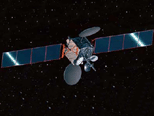In Venezuela the first law on telecommunications was approved in 1940. It identified the responsibility of the state in regard to telephone and other telecommunication systems, including radio and television services.

The Hughes Aircraft Company was a major American aerospace and defense contractor founded on February 14, 1934 by Howard Hughes in Glendale, California, as a division of Hughes Tool Company. The company produced the Hughes H-4 Hercules aircraft, the atmospheric entry probe carried by the Galileo spacecraft, and the AIM-4 Falcon guided missile.

STS-51-I was the 20th mission of NASA's Space Shuttle program and the sixth flight of Space Shuttle Discovery. During the mission, Discovery deployed three communications satellites into orbit. The mission launched from Kennedy Space Center, Florida, on August 27, 1985, and landed at Edwards Air Force Base, California, on September 3, 1985.
PanAmSat Corporation was a satellite service provider headquartered in Greenwich, Connecticut, United States. Founded in 1984 by Reynold "Rene" Anselmo, it operated a fleet of communications satellites used by the entertainment industry, news agencies, internet service providers, government agencies, and telecommunication companies. Anselmo got the idea for PanAmSat from Norm Leventhal, a communications lawyer in Washington, D.C., to whom he had turned to for advice regarding difficulties he was encountering in getting reasonably priced satellite transmission for his Spanish International Network (SIN), the current-day Univision. Anselmo financed the entire project himself and Leventhal's law firm, hiring Martin Rothblatt for special satellite technical advice, filed for approval from the Federal Communications Commission (FCC) and lining up an initial satellite from RCA Astro-Electronics and a heavily discounted launch from Arianespace.

AsiaSat 3, previously known as HGS-1 and then PAS-22, was a geosynchronous communications satellite, which was salvaged from an unusable geosynchronous transfer orbit (GTO) by means of the Moon's gravity.

Nickelodeon is a children's channel broadcasting in Denmark, Norway and Finland. It broadcasts programming from the similarly branded channels in the United Kingdom and the United States as well as a few locally produced programmes.

Hughes Electronics Corporation was formed in 1985 when Hughes Aircraft was sold by the Howard Hughes Medical Institute to General Motors for $5.2 billion. Surviving parts of Hughes Electronics are today known as DirecTV Group, while the automotive divisions became Aptiv.
The Galaxy series is a family of communications satellites originally developed and operated by Hughes Communications. It has since merged with PanAmSat and is now owned and operated by Intelsat. As one of the earliest geostationary satellites, Galaxy 1 was launched on 28 June 1983. The latest one, Galaxy 37, was launched on 3 August 2023.
Intelsat 2, formerly PAS-2, was a communications satellite operated by Intelsat which spent most of its operational life serving the Pacific Rim market from a longitude of 169° East. Launched in July 1994, the satellite was operated by PanAmSat until it merged with Intelsat in 2006. The spacecraft was renamed, along with the rest of PanAmSat's fleet, on 1 February 2007.
Intelsat 3R is a communications satellite owned by Intelsat located at 43° West longitude, serving the Americas market.
Horizons Satellite is a joint venture between Intelsat and SKY Perfect JSAT Group. Originally formed in 2001, pursuant to a memorandum of understanding between JSAT Corporation and PanAmSat for the launch of Horizons-1, it was renewed for Horizons-2. JSAT later merged into the SKY Perfect JSAT Group and PanAmSat was acquired by Intelsat, but the companies continued with the relationship, with the order for Horizons-3e. Both companies also launched a joint satellite, Intelsat 15/JCSAT-85, but instead of the equal share agreement of this joint venture, JSAT owns a specific payload of 5 transponders out of the 22 Ku band transponders of the spacecraft.
Galaxy 11 is an American geostationary communications satellite which is operated by Intelsat. It is located in geostationary orbit at a longitude of 32.8 degrees east, where it serves as a backup to the Intelsat 802 spacecraft. It was originally operated at 99° West and later spent most of its operational life at 91° West, from where it was used to provide communications services to Brazil and North America.
Intelsat 5 was a satellite providing television and communication services for Intelsat, which it was commissioned by in 2006.
American Satellite Company (ASC) was one of many Fairchild Industries subsidiary companies and was established in partnership with Continental Telephone in 1972. Emanuel Fthenakis was the President and Chief Executive Officer upon the founding of the corporation. He was replaced in 1976 by Harry Dornbrand, who was President of Fairchild Space and Electronics division at the time. Under their leadership, ASC pioneered advancements in satellite broadcasting both domestically and abroad.
Horizons-1, also known as Galaxy 13, is a geostationary communications satellite operated by Intelsat and SKY Perfect JSAT (JSAT) which was designed and manufactured by Boeing on the BSS-601 platform. It has Ku-band and C-band payload and was used to replace Galaxy 9 at the 127.0° West longitude. It covers North America, Puerto Rico, Alaska, Hawaii and Mexico.
Horizons-3e, also known as IS-H3e, is a high throughput geostationary communications satellite ordered by Horizons Satellite, a joint venture of Intelsat and SKY Perfect JSAT Group. The spacecraft is designed and manufactured by Boeing on the Boeing-702MP platform.
Galaxy 9 (G-9) was a geostationary communication satellite built by Hughes. It was located at an orbital position of 81 degrees west longitude and was initially operated by PanAmSat and later by Intelsat. The satellite was based on the HS-376 platform and its life expectancy was 15 years. The satellite was successfully launched into space on May 23, 1996, at 01:09:59 UTC, by means of a Delta II vehicle from Cape Canaveral Air Force Station, United States. It had a launch mass of 3080 pounds.
PAS-3, was a communications satellite for PanAmSat. Launched in December 1994.
PAS-6 was a communications satellite owned by PanAmSat and serving the South America market.




